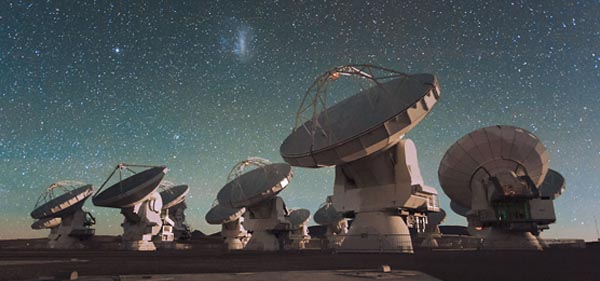Telescopes
Optical Telescopes
Refracting Telescopes
Until the 17th century the only way to observe the heavens was by the naked eye. In 1608 a device, now known as a telescope, was invented that used a concave and convex mirror housed in a tube to bend light and magnify distant objects. Telescopes that use lenses are known as refracting telescopes. Early telescopes suffered from quality issues with the glass. Lenses typically contained tiny bubbles and iron impurities that reduced the quality of the image. Nevertheless they were a huge improvement on the unaided eye. Refracting telescopes soon became available across Europe. The well known scientist Galileo Galilei produced refracting telescopes and developed the design to produce higher magnifications of up to thirty times.
Reflecting Telescopes
In the mid 17th century a new type of telescope, the Reflecting telescope, appeared. Designed by Isaac Newton in 1668 the reflecting telescope consisted of two polished metal mirrors. A curved mirror at the back of the telescope enlarged the incoming light from the object and focused it on a small flat mirror at the front of the telescope, which reflected it at an angle to be viewed from the side of the telescope. The planet Uranus was discovered by William Herschel in 1781 using a seven foot long reflecting telescope. The mirrors in reflectors, however, suffered from tarnishing and required regular polishing. They also blurred the image as much as a refracting lens.
Better Optics
During the 19th century optical technology improved to the point where the lens based refracting telescope saw a comeback. The main problem with refracting telescopes was the chromatic aberration caused by different colours being bent slightly differently by the lens resulting in each colour having a different focal point. This was overcome by having two lens, one to bend the light and another to compensate for the different focal lengths by bending the light again to make the focal points for all colours co-incident.
Spectroscopy
Once lenses reproduced colours accurately telescopes became used for determining the makeup of the stars as well as for studying their movements. In 1859 two scientists, Kirchhoff and Bunsen, developed the technique of spectroscopy for analyzing the chemical composition of chemical elements. When heated, chemicals produced light that could be dispersed using a prism to produce a spectrum, some of the lines in the spectrum being brighter than others. Each elements produced a different unique pattern of bright lines. These patterns were the equivalent of a finger print that could be used to identify an elements presence in a burning star millions of light years away. Between 1885 and 1890 over 10,000 stars had been recorded and cataloged. By 1924 this number had been increased to over a quarter of a million.
Astrophotography
The newer high quality lenses encouraged the use of telescopes for taking photographs of the universe around us. In 1840 the first photograph of the Moon was taken by J.W.Draper. This was followed by the first solar eclipse in 1842 and the first photographs of the Sun in 1845. As photographic techniques improved so did the quality of the images allowing much fainter objects to be recorded. By the 20th century astrophotography had become an accepted way of permanently recording the images seen through a telescope.
Another circle
Reflector telescopes though had not been completely overshadowed. Mirror technology improved during the early 20th century and new techniques for producing large glass castings, polishing and applying thin metal layers to glass meant that reflector telescopes became competitive again. They also had the advantage of being smaller that the equivalent refractor telescope. The 200 inch Hale telescope built by Caltech on Mount Wilson was a massive undertaking in the late 1920's. In addition to the challenges of building the telescope and mirrors, the mounting required to support and turn the giant telescope pushed the boundaries of technology to its limits at the time.
The Hale telescope served as a template for most modern telescopes and it continues in service to this day.
Radio telescopes
During the early 19th century effort was being put into the investigation and understanding of electricity and magnetism. James Maxwell summed everything up with his theory of electromagnetism that describe the propagation of electromagnetic waves. There were lots of subsequent experiments intended to support the theory but it wasn't until the late 19th century that work to find a practical means of using electromagnetic waves for wireless communications were undertaken. In 1897 Gugliemo Marconi conducted experiments that concluded with the first commercial application of radio.
Development of radio technology accelerated during the early 20th century and, in 1932, as part of an assignment to investigate the interference created by static, Karl Jansky built a receiver mounted on four wheels that could be rotated 360°. Over a period of months Jansky identified all sorts of natural sources of static. In addition he noticed a faint background noise that seemed to be more intense at a certain part of the sky and repeated it self every 23 hours and 56 minutes. It turned out the noise was from our galaxy and the loudest came from the center.
The advent of World War Two saw unprecedented effort into developing technology. Radio and Radar were two of the most demanding areas and saw fantastic progress. After the war many academic institutions started to apply this new technology in the quest to understand the universe. Initially expectations were low but in 1965 two researchers at Bell Labs, Arno Penzias and Robert Wilson, whilst investigating radio sources from the Milky Way, detected a background noise that appeared to be coming from all directions and from sources outside of our galaxy. This turned out to be radiation caused by the Big Bang.
Since that time radio telescopes have become more common, more sophisticated and put to more uses such as listening for signs of extra-terrestrial life as well as discovering more about the structure of the universe.
